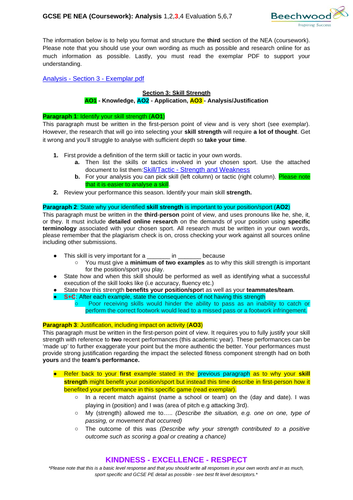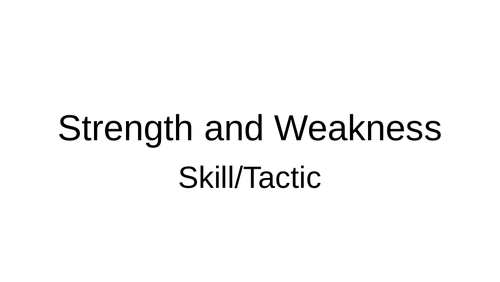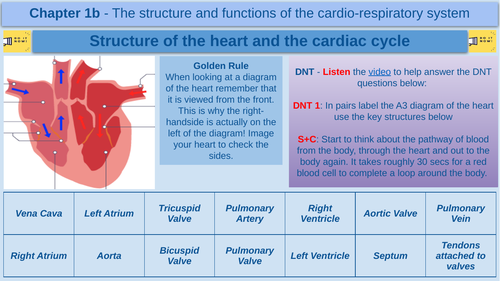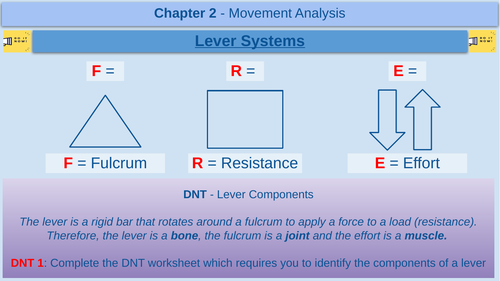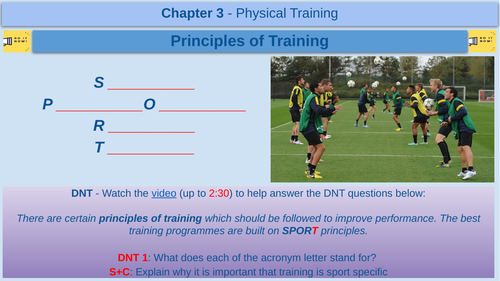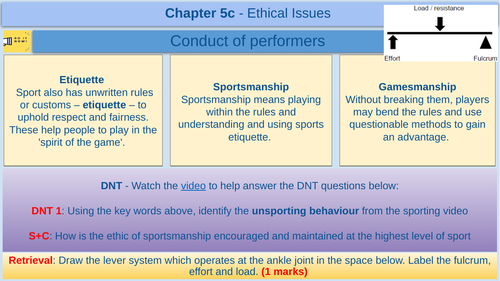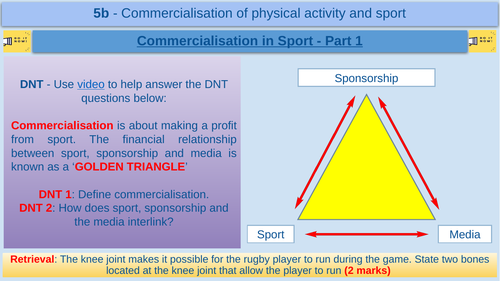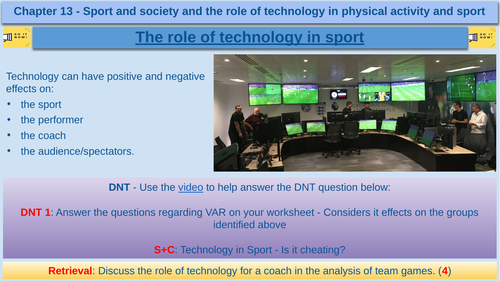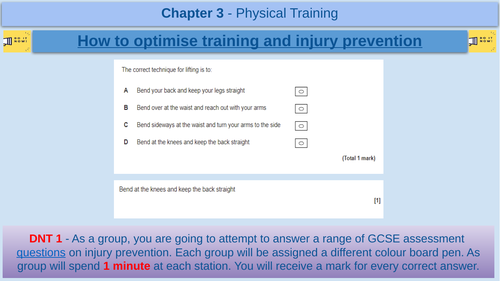
221Uploads
31k+Views
7k+Downloads
Physical education
Sale

AQA GCSE PE NEA Coursework Guide - Analysis Section 3 (Skill Strength)
This resource includes;
A complete, top scoring, exemplar for section 3 (Skill Strength) the AQA GCSE PE coursework task.
A step by step guide, containing sentence starters and checklists to help students structure and keep track of the tasks they have completed.
This exemplar uses the sport of netball and is written by a teacher to showcase a top grade and meet all of the assessment objectives given in the specification marking grid.
Sale

AQA GCSE PE NEA Coursework Guide - Analysis Section 4 (Skill Weakness)
This resource includes;
A complete, top scoring, exemplar for section 4 (Skill Weakness) the AQA GCSE PE coursework task.
A step by step guide, containing sentence starters and checklists to help students structure and keep track of the tasks they have completed.
This exemplar uses the sport of netball and is written by a teacher to showcase a top grade and meet all of the assessment objectives given in the specification marking grid.
Sale

Self-efficacy and Confidence
Chapter 12.1 - Psychological factors that can influence an individual in physical activities
Resource includes PowerPoint presention and differentiated worksheets for a 1 hour lesson, following the AQA specification.
Students will be able to:
AO1: To identify the factors affecting self-efficacy and confidence
AO3: To analyse both Vealey and Bandura’s models on sports confidence
AO3: To discuss possible strategies used to develop sport confidence
Feedback is welcome, please check out the rest of my lessons.
Sale

MYP Physical and Health Education E-portfolio 2020 Task 1
This exemplar was created to support students during their 2020 E-Portfolio for IB in response to the given Unit Planner and statement of inquiry.
SOI: Developing to be the best we can be, positively impacts our futures
Task 1: Initial observations and analysis (as a coach) supports the students to meet criterion A assessment statements and provides an example bibliography.
Sale

Structure of the heart and the cardiac cycle - GCSE Physical Education - AQA
Resource includes PowerPoint presention and differentiated worksheets for a 1 hour lesson, following the AQA specification.
Chapter 1b - The structure and functions of the cardio-respiratory system
Lesson 1: Structure of the respiratory system and Gaseous exchange
Lesson 2: Mechanics of breathing and Lung Volumes
Lesson 3: Blood Vessels and Redistribution of blood
Lesson 4: Structure of the heart and the cardiac cycle
Lesson 5: Cardiac Output
Sale

Lever Systems - GCSE Physical Education - AQA
Resource includes PowerPoint presention and differentiated worksheets for a 1 hour lesson, following the AQA specification.
Chapter 2 - Movement Analysis
Lesson 1 - Lever systems
Lesson 2 - Mechanical advantage
Lesson 3 - Planes and axes of movement
Lesson 4 - Movement Analysis
Sale

Principles of Training - GCSE Physical Education - AQA
Resource includes PowerPoint presention and differentiated worksheets for a 1 hour lesson, following the AQA specification.
Chapter 3 - Physical Training
Lesson 1 - Relationship between health and fitness
Lesson 2 - Components of Fitness - Health Related
Lesson 3 - Components of Fitness - Skill Related
Lesson 4 - Fitness Testing - Part 1
Lesson 5 - Fitness Testing - Part 2
Lesson 6 - Use of Data
Lesson 7 - Principles of Training
Lesson 8 - Methods of Training
Lesson 9 - Training seasons and injury prevention
Practical - Physical Training Lessons
Sale

Types of Feedback - GCSE Physical Education - AQA
Resource includes PowerPoint presention and differentiated worksheets for a 1 hour lesson, following the AQA specification.
Chapter 4 - Sports Psychology
Lesson 1 - Classification of Skills
Lesson 2: SMART Targets
Lesson 3: Information Processing Model
Lesson 4: Types of Guidance
Lesson 5: Types of Feedback
Lesson 6: Inverted-U Theory - Arousal and Stress Management
Lesson 7: Aggression
Lesson 8: Personality Types & Motivation
Sale

Conduct of performers - GCSE Physical Education - AQA
Resource includes PowerPoint presention and differentiated worksheets for a 1 hour lesson, following the AQA specification.
Chapter 5c - Ethical Issues
Lesson 1 - Players’ conduct
Lesson 2 - Prohibited Substances
Lesson 3 - Spectator Behaviour
Sale

Technology in Sport - GCSE Physical Education - AQA
Resource includes PowerPoint presention and differentiated worksheets for a 1 hour lesson, following the AQA specification.
5b - Commercialisation of physical activity and sport
Lesson 1: Commercialisation in Sport - Part 1
Lesson 2: Commercialisation in Sport - Part 2
Lesson 3: Technology in Sport
Sale

Commercialisation in Sport - Part 1 - GCSE Physical Education - AQA
Resource includes PowerPoint presention and differentiated worksheets for a 1 hour lesson, following the AQA specification.
5b - Commercialisation of physical activity and sport
Lesson 1: Commercialisation in Sport - Part 1
Lesson 2: Commercialisation in Sport - Part 2
Lesson 3: Technology in Sport
Sale

Health, well-being and fitness - GCSE Physical Education - AQA
Resource includes PowerPoint presention and differentiated worksheets for a 1 hour lesson, following the AQA specification.
Chapter 6 - Health and Fitness
Lesson 1: Health, well-being and fitness
Lesson 2: Sedentary Lifestyle
Lesson 3: Somatotypes
Lesson 4: Diet and Energy Sources
Sale

Somatotypes - GCSE Physical Education - AQA
Resource includes PowerPoint presention and differentiated worksheets for a 1 hour lesson, following the AQA specification.
Chapter 6 - Health and Fitness
Lesson 1: Health, well-being and fitness
Lesson 2: Sedentary Lifestyle
Lesson 3: Somatotypes
Lesson 4: Diet and Energy Sources
Sale

Baddeley and Hitch’s working memory model
Chapter 9.1 - Information Processing
Resource includes PowerPoint presention and differentiated worksheets for a 1 hour lesson, following the AQA specification.
Students will be able to:
AO1: To describe the key features and functions of the working memory model
AO2: To apply this knowledge to sporting situations
AO3: To analyse how Baddeley and Hitch’s model allows a performer to make effective decisions
Feedback is welcome, please check out the rest of my lessons.
Sale

Schema Theory
Chapter 9.1 - Information Processing
Resource includes PowerPoint presention and differentiated worksheets for a 1 hour lesson, following the AQA specification.
Students will be able to:
AO1: To describe Schmidt’s schema theory
AO2: To apply the schema theory in sporting situations
AO3: To analyse the strategies to improve information processing
Feedback is welcome, please check out the rest of my lessons.
Sale

Concepts of physical activity and sport
Chapter 13 - Sport and society and the role of technology in physical activity and sport
Resource includes PowerPoint presention and differentiated worksheets for a 1 hour lesson, following the AQA specification.
Students will be able to:
AO1: To identify the characteristics and functions of Physical Recreation, Sport, Physical Education and School Sport.
AO2: To explain the similarities and differences between the key concepts.
AO2: To explain how these difference might impact performance
Feedback is welcome, please check out the rest of my lessons.
Sale

The role of technology in sport
Chapter 13 - Sport and society and the role of technology in physical activity and sport
Resource includes PowerPoint presention and differentiated worksheets for a 1 hour lesson, following the AQA specification.
Students will be able to:
AO1: To understand how the development of equipment and facilities impact on participation and performance.
AO2: To explain how technology in sport has positive and negative effects on the performer, coach, audience and the sport
AO3: Discuss the overall impact of technology in sport
Feedback is welcome, please check out the rest of my lessons.
Sale

AQA GCSE PE NEA Coursework Guide - Analysis Section 2 (Fitness Weakness)
This resource includes;
A complete, top scoring, exemplar for section 2 (Fitness Weakness) the AQA GCSE PE coursework task.
A step by step guide, containing sentence starters and checklists to help students structure and keep track of the tasks they have completed.
This exemplar uses the sport of netball and is written by a teacher to showcase a top grade and meet all of the assessment objectives given in the specification marking grid.
Sale

Injury Prevention - GCSE Physical Education - AQA
Resource includes PowerPoint presention and differentiated worksheets for a 1 hour lesson, following the AQA specification.
Chapter 3 - Physical Training
Lesson 1 - Relationship between health and fitness
Lesson 2 - Components of Fitness - Health Related
Lesson 3 - Components of Fitness - Skill Related
Lesson 4 - Fitness Testing - Part 1
Lesson 5 - Fitness Testing - Part 2
Lesson 6 - Use of Data
Lesson 7 - Principles of Training
Lesson 8 - Methods of Training
Lesson 9 - Training seasons and injury prevention
Practical - Physical Training Lessons
Sale

Attribution Theory
Chapter 12.1 - Psychological factors that can influence an individual in physical activities
Resource includes PowerPoint presention and differentiated worksheets for a 1 hour lesson, following the AQA specification.
Students will be able to:
AO1: To identify the concepts of attribution theory, self-serving bias and learned helplessness
AO2: To apply these concepts to sporting situations
AO3: To suggest strategies to prevent learned helplessness from occurring
Feedback is welcome, please check out the rest of my lessons.

